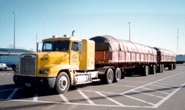Shipping and Logistics

ATA Reports “Choppy” Year for Tonnage in 2019
Written by Sandy Williams
January 24, 2020
The trucking industry reported a “choppy” year for truck tonnage. The American Trucking Association’s advanced seasonally adjusted For-Hire Truck Tonnage Index increased for the 10th year in 2019, but at only half the gain realized in 2018. The index was up 3.3 percent compared to 6.7 percent in 2018.
The SA December Index rose 4.0 percent after falling 3.4 percent, posting a reading of 118.2. ATA noted that tonnage data is dominated by contract freight.
“Last year was not a terrible year for for-hire truck tonnage, and despite the increase at the end of the year, 2019 was very uneven for the industry,” said ATA Chief Economist Bob Costello. “The overall annual gain masks the very choppy freight environment throughout the year, which made the market feel worse for many fleets. In December, strong housing starts helped advance the index forward.”
The Cass Freight Index indicated a 7.9 percent year-over-year drop in overall shipment volumes during December.
“Our view is that the second quarter of 2020 has the best chance of seeing actual year-over-year growth in shipments and freight costs, if traditional seasonal freight patterns hold,” said Cass Information Systems in the December Cass Freight Index Report.

“And while we expect comps to ease and volumes to flatten out, we are not forecasting much growth in terms of freight volumes in 2020. The U.S. industrial economy – rebound or no rebound – will likely be the biggest swing factor,” said Cass. “And the tariff relief from the Phase 1 deal seems to be just that – a relief for some, but not a stimulus.”
Spot rates appeared to be stabilizing in early January after hitting bottom in mid-2019. However, rates during the week of January 13-19 dropped for vans and reefers, indicating the start of a slump that DAT Trendlines expects to end around mid-March.
Flatbed rates, normally down at this time of year, are in a surprising rebound. DAT attributes higher demand from the oil industry as oil rig counts increase in the U.S. and Canada. The national average flatbed rate is up 7 cents from November to $2.19 per mile.
The trucking industry serves as a barometer of the U.S. economy, said ATA. The industry moves more than 70 percent of the tonnage carried by all modes of domestic freight transportation, including manufactured and retail goods.

Sandy Williams
Read more from Sandy WilliamsLatest in Shipping and Logistics

US Great Lakes iron ore cargoes down notably through May
The Lake Carriers' Association reported a considerable decline in monthly iron ore shipments from US ports on the Great Lakes.

Wittbecker: West Coast port congestion
What's going on in West Coast ports?

Wittbecker: Mexico invests in port capacity despite US tariff troubles
The Mexican government aims to transform Manzanillo into the largest seaport in Latin America, capable of processing some 10 million TEU (20-foot equivalent units) per year by 2030. It is already Mexico's largest port and the third largest in Latin America, handling nearly 4 million 20-foot containers in 2024.

Wittbecker on Aluminum: When do the tariffs reach Main Street?
Containers sailing from China in April are down 15%-20% and Hapag Lloyd says their future bookings transpacific are down 30%.

Wittbecker on Aluminum: US-China trade war clobbers cross-Pacific trade
Container shipping lines have sharply increased blank sailings on Transpacific routes in response to escalating trade tensions between the US and China.
